Chapter: Mathematics (maths) : Applications of Partial Differential Equations
Important Questions and Answers: Applications of Partial Differential Equations
APPLICATIONS OF PARTIAL DIFFERENTIAL EQUATIONS
PART
–A
1. What conditions are
assumed in deriving the one dimensional wave equation?
The wave equation is

In
deriving this equation we make the following assumptions.
(i) The
motion takes place entirely in one plane i.e., XY plane.
(ii) We consider
only transverse vibrations
the horizontal displacement
of the
particles
of the string is negligible.
(iii)The
tension T is constant at all times and at all points of the deflected string.
(iv)
T is considered to be so large compared
with the weight of the string and hence the force of gravity is negligible.
(v) The
effect of friction is negligible.
(vi)
The string is perfectly flexible.
2.State the wave
equation and give the various solutions of it?

The
various possible solutions of this equation are
(i) y(x,t)
=( A1e px
+A2
e-px
)(
A3e pat +A4
e-pat
)
.
(ii) y(x,t)
=( A5 cos
px +A6
sin
px)( A7 cos pat +A8
sin
pat)
(iii) y(x,
t) =( A9
x +A10
)(
A11t +A12
)
.
3. Find the nature of
PDE

Here
A =4, B =4,C=.1
B2-4AC=16-4(4)(1)=0.
Therefore
the equation is Parabolic.
Classify the equation uxx-y4uyy=2y3uy.
Solution:
This
is of the form Auxx+Buxy+Cuyy+f(x,y,u,ux,uy)=0.
Here
A=1, B=0, C=-1.
B2-4AC=0-4(1)(-1)=4>0.
Therefore
the equation is Hyperbolic.
2. Classify:
x2uxx+2xyuxy+(1+y2) uyy-2ux=0.
Solution:
This
is of the form Auxx+Buxy+Cuyy+f(x,y,u,ux,uy)=0.
Here
A=x2, B=2xy, C=1+y2.
B2-4AC=4x2y2-4(x2)(1+y2)
=
4x2y2-4 x2-4(x2 y2)
=-4x2<0.
Therefore
the equation is Elliptic.
3. A string
is stretched and fastened
to two point l
apart. Motion is started by
displacing the string
into the form y
=y0
sin
px/ l from which it is released at time t=0. Formulate
this problem as the boundary value problem. Solution:
The displacement y(x,t)
is the solution of the wave equation.

The boundary conditions
are:

4. What is the constant a2 in
the wave equation

Solution:
u(x,
t) =( Acos px +B sin px)e-c2
p2t
.
6. State
the governing equation for one dimensional heat equation and necessary
conditions to solve the problem.
Solution:

temperature at time t at a point
distance x from the left end of the rod.
The
boundary conditions are
i)
u(0, t) =k 01C
for all t Âł0
ii)
u(l, t)
=k
02C for all t Âł0
iii)
the initial condition is u(x,0)
=f
(x), 0 <x
<l
.
7.Write all variable separable solutions
of the one dimensional heat equation

Solution:
i) u(x,
t) =( A1elx +B2
e-lx
)C1ea2l2t
ii)u(x,t)
=( A2 cos
lx +B2
sin
lx)
C2 e-a2l2t
iii) u(x,
t) =( A3
x +B3
)C3
.
8. Write
down the diffusion problem in one dimension as a boundary value problem in two
different forms.
Solution:
9. State
any two laws which are assumed to derive one dimensional heat equation.
Solution:
i)
Heat flows from higher to lower
temperature
ii)
The rate at which the heat flows across
any area is proportional to the area and to the temperature gradient normal to
the curve. This constant is proportionality is known as the thermal
conductivity (k) of the material. It is known as Fourier law of heat
conduction.
10.
Write any two solutions of the
Laplace equation Uxx+Uyy=0 involving exponential terms in
x or y.
Solution:
i) u(x,
y) =( A1e
px +A2
e-px
)(
A3 cos py +A4
sin
py ) .
ii) u(x,
y) =( A1
cos px +A2
sin
px)( A3e py
+A4
e-py
)
.
11.
In steady state conditions derive
the solution of one dimensional heat flow equation. Solution:
The PDE of unsteady one dimensional heat flow is

In steady state condition, the
temperature u depends only on x and not on t.

The
general solution is u=ax+b, where a, b are arbitary.
12.
Write the boundary condition and
initial conditions for solving the vibration of string equation, if the string
is subjected to initial displacement f(x) and initial velocity g(x).
Solution:

The
initial and boundary conditions are
i) y(0,
t) =0 .
ii) y(l,
t) =0 .
iii) ¶y
(x,0)=g(x) .
¶t
iv) y(x,0)
=f (x)
Write down the governing equation of two
dimensional steady state heat equation. Solution:

14.
The ends A and B of a rod of length
10cm long have their temperature distribution kept at 20oC and 70oC.
Find the steady state temperature distribution of the rod. Solution:
The
steady state equation of one dimensional heat flow is

The boundary conditions are u(0)=20, u(l)=70.
Put x=0 in (2) we get u(0)=a(0)+b
Ăžb=20
Put x=l
in (2) we get u(l)=al+b
70= al+20 al=50
a=
50/l
Therefore
equation (2) Ăž u(x)= 50x/l+20
Here
l=10 cm
Therefore u(x)= 50x/10+20 u(x)=5x+20.
15.
Write down the different solutions
of Laplace equation in polar coordinates.

i) u(r,q) =(C1r
p +C2
r -p
)(C3 cos pq+C4
sin pq)
ii) u(r,q) =(C5
cos( p log r) +C6
sin(
p log r)(C7 e pq +C8e-pq)
iii) u(r,q) =(C9
log r +C10
)(C11q+C12
)
.
16.
What is the general solution of a
string of length l whose end points are fixed and which starts from
rest?
Solution:

17.
How many boundary conditions and
initial conditions are required to solve the one dimensional wave equation?
Solution:
Two boundary conditions and two initial conditions
are required.
PART
B
1.A string is stretched and fastened to
two points x = 0 and x= l apart. Motion is started by displacing the string
into the form y = k (l x –x2 ) from which it is released at time
t=0. Find the displacement of any point on the sting at a distance of x from
one end at time t.
Solution: The
ODWE ytt=c 2 ycc
Solution : y(x,t)=
(Acos px +Bsin px)(Ccos pct +Dsin pct)
Boundary
and initial conditions are (i) y(0,t) = 0 (ii) y(l,t) = 0
(iii)
y t (x,0)=0 (iv) y(x,0)=f(x), 0< x < l .
Using
Boundary and initial conditions:
i)
y(0,t) = 0, put x=0
A(Ccos pct +Dsin pct)=0 \
A=0
\ Suitable solution y(x,t)= Bsin px (Ccos pct +Dsin pct)
ii) y(l,t) = 0 , put x=l
Bsin
pl (Ccos pct +Dsin pct)=0 ĂžB
Âą0 Bsin pl =0

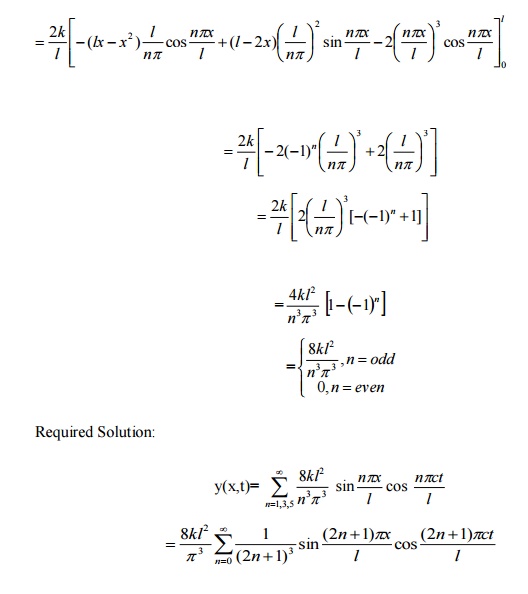
2.A taut string of
length 2l is fastened at both ends . The midpoint of the string is taken
to a height b and then released from rest in that position. Find the
displacement of the string at any time.
Solution:
let L=2l
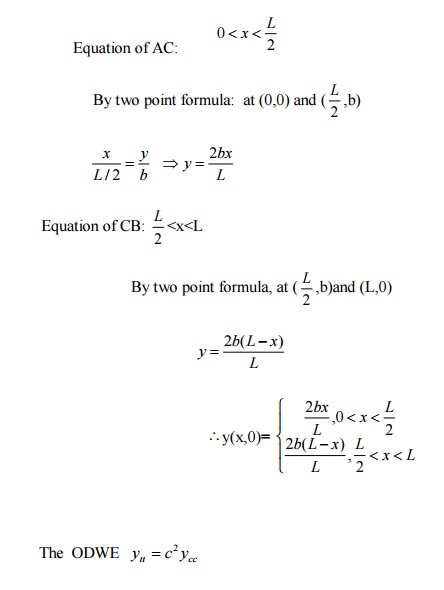
Suitable solution y(x,t)=
(Acos px +Bsin px)(Ccos pct +Dsin pct)
Boundary and initial conditions are
(i) y(0,t) = 0 (ii) y(l,t) = 0 (iii) y t
(x,0)=0 (iv) y(x,0)=f(x), 0< x < l .
Using Boundary and initial conditions:
i) y(0,t) = 0, put x=0
A(Ccos
pct +Dsin pct)=0 \ A=0
Suitable solution y(x,t)= Bsin px (Ccos pct +Dsin
pct)
ii) y(l,t)
= 0 , put x=l
Bsin pl (Ccos pct +Dsin pct)=0 ĂžB Âą0
Bsin pl =0


3.If a string of length ' l '
is initially at rest in its equilibrium position and each of its points

Suitable solution y(x,t)=
(Acos px +Bsin px)(Ccos pct +Dsin pct)
Boundary and initial conditions are (i) y(0,t) = 0 (ii) y(l,t) = 0
(iii) y (x,0)=0 (iv) y t (x,0)=f(x) =v0 sin3 px / l
Using Boundary and initial conditions:
i) y(0,t) = 0, put x=0
A(Ccos
pct +Dsin pct)=0 \ A=0
\ Suitable solution y(x,t)= Bsin px (Ccos pct +Dsin pct)
ii) y(l,t)
= 0 , put x=l
Bsin pl (Ccos pct +Dsin pct)=0 ĂžB Âą0
Bsin pl =0
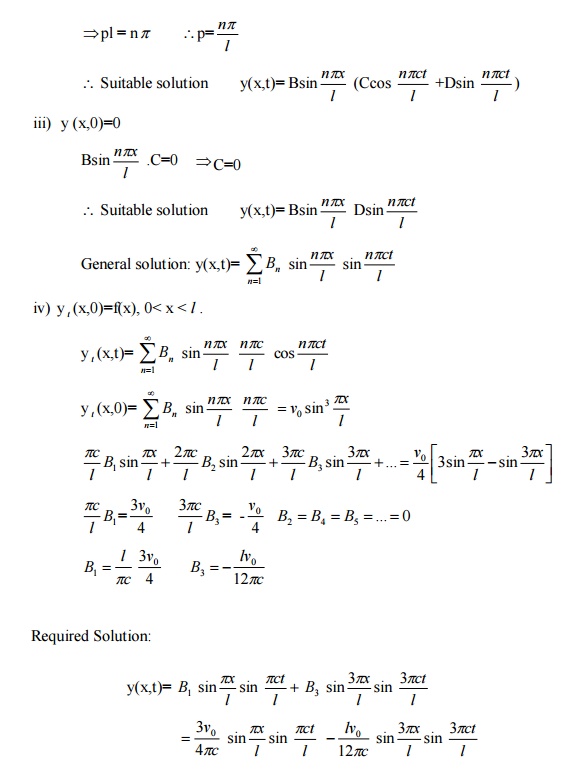
4.A rod 30 cm long has its ends A and B
kept at 200C and 800C respectively until steady state
conditions prevail the temperature at each end is then suddenly reduced to 00
c and kept so. Find the resulting temperature function u(x,t) taking x=0 at A.
Solution:
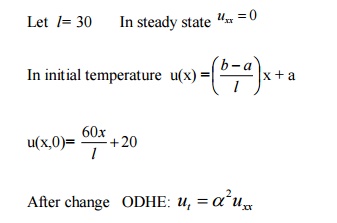
After change
ODHE: ut =a2uxx
Suitable Solutions:
u(x,t)=
(Acospx + Bsin px) e-a2
p2t
Boundary and Initial Conditions:

Using Boundary and initial conditions:
i) u(0,t)=0
Here x=0 Ăž
u(0,t)= Ae -a2
p2t
\A=0


5. An infinitely long
rectangular plate with insulated surface 10 cm wide. The two long edges and one
short edge are kept at 00 temperature, while the other short edge
x=0 is kept at temperature given by u=20y, 0 ÂŁy
ÂŁ5, u=20(10-y),5 ÂŁy ÂŁ10.
Find the steady state temperature in the plate.
Solution :
Steady state two dimensional heat equation:
uxx
+uyy =0
Infinite plate extended in x-direction : Let l=10
I Boundary Conditions
i) u(x,0) = 0
ii) u(x,l) = 0

II Suitable Solution:
u(x,y)=
(Ae
-px
+Be
px )(Ccospy +
Dsinpy)
Using boundary conditions:
u(x,0) = (Ae-px +Be px
)C =0
C=0
Suitable Solution:
u(x,y)= (Ae
-px
+Be
px )Dsinpy
ii) u(x,l)
= 0

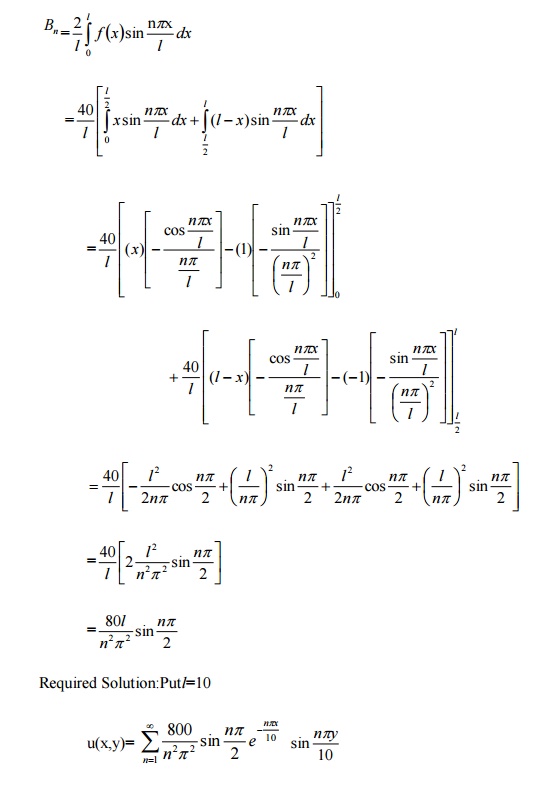
Related Topics